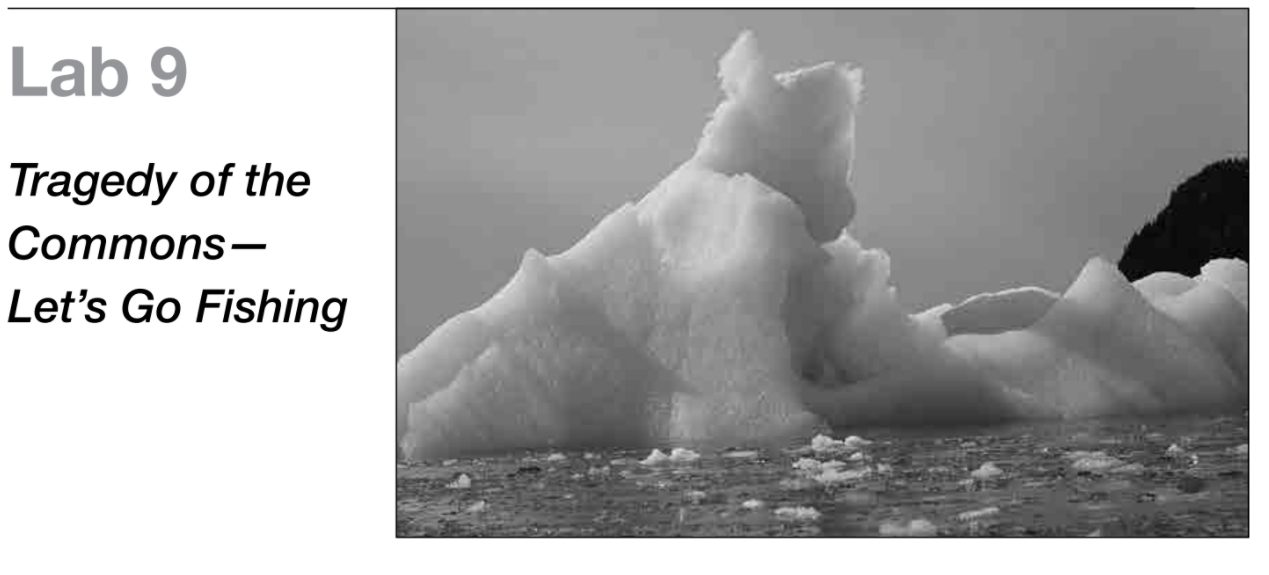Conservation Biology and the Tragedy of the Commons

Pre-lab Reading
In lecture you have already discussed, or will soon discuss, the subject of conservation biology (Chapter 38 in your textbook). Conservation biology is a discipline within the field of biology that is trying to stop the current biodiversity crisis in which many species around the planet are going extinct. While there are many reasons for the current biodiversity crisis, three reasons in particular are the major human-caused threats to the survival of many species: habitat destruc-tion, invasive species, and overexploitation of resources. Prudent management of resources, such as logging, agriculture, hunting, or fishing, has the potential to alleviate many of these threats.
The Tragedy of the Commons is the notion that any resource that is open to everyone—such as the air, a pasture for grazing cattle, or parts of the ocean—will eventually be destroyed be-cause everyone can use the resource but no one is responsible for preserving it. When people are not compelled to preserve resources for the welfare of future generations, the Tragedy of the Commons occurs because the resource becomes depleted for society as a whole. For example, a commercial fish species goes extinct, or a pasture for grazing cattle no longer has grass and cattle can’t graze there anymore, etc.
In the following laboratory exercise students will conduct an exercise in which they exploit a commonly held resource—fish in a lake. Through this exercise, the subsequent questions, and articles on resource management, students should gain an understanding of the Tragedy of the Commons. In this lab students will also apply this understanding to resource management in multiple circumstances and formulate ideas about how society can avoid the Tragedy of the Commons for some commonly held resources.
On-Campus and Online Pre-lab Assignment
Case Study
Mangrove ecosystems are at the interface of land and sea. They are comprised of salt-tolerant tree species as well as many terrestrial and marine animal species. Mangroves provide many ecosystem services, resources or processes provided by the natural environment from which humans benefit. For example, many commercial fish, crab, and prawn species rear their young in mangroves. In fact, many indigenous communities often collect crabs and other food sources from the mangroves in a sustainable manner. Additionally, mangroves filter pollutants out of water and absorb wave ac-tion from the ocean, which dissipates the energy so that structures on the land are not as severely impacted by the waves.
In most countries coastal areas are government-controlled, and mangroves are exclusively located in coastal areas. Since the early 1980s governments have given large land leases to commercial shrimp farming corporations that remove the mangroves and replace them with holding ponds for shrimp. Ever eaten all-you-can-eat shrimp? Usually they come from these shrimp farms in Central America or southeast Asia. Generally shrimp farms can only farm in the same place for a few years before the water becomes either too polluted or the salt concentration is too high to continue farming shrimp. At this point they often apply for a lease from the government to farm in a new area of mangroves and leave the old land abandoned and polluted.
Between 1980 and 2001, 20–35% of the mangrove habitat in the world was destroyed, mostly be-cause of shrimp farms. On average, 2% of the world’s mangroves are destroyed every year. This rate is higher than rainforest destruction or any other terrestrial habitat. It is estimated that at this rate of destruction in 100 years mangroves could become functionally extinct. Growing pressure from urbanization along coastlines combined with predictions of sea-level rise from global warming il-lustrate the need for coastal wetland restoration, such as mangroves.
Online Lab 9: The Tragedy of the Commons
Materials
• Online simulator (fishing game—see link from your instructor) •
• Graphing program, such as Excel
Methods
This exercise requires you to play the fishing game (online simulator). Play according to the instruc-tions below. Record the number of fish taken by you and the other boats in the simulation in the datasheet. Be sure to record the number of fish in the lake at the beginning of each round. Answer the associated questions.
Game 1
1. In this game, imagine yourself as the head of a family. Try to provide for your family by earning money for food, supplies, and all the other necessities of life. You can fish as much or as little as you want.
2. The game begins with 20 fish in the lake. Each round you will choose to take zero, one, two, or three fish.
3. Record the number of fish taken by you and the other boats in the simulation.
4. Be sure to record the number of fish in the lake at the beginning of each round.
5. Make a graph with lines a) showing the total number of fish in the lake over 10 days and b) the total number of fish removed from the lake over 10 days.
Game 2
1. Play the game a second time with the goal of being able to fish all 10 days. Hint: Try to not exhaust your resources, while also making sure you and your family survive.
2. The game begins with 20 fish in the lake. Each round you will choose to take zero, one, two, or three fish. Be sure to record the number of fish in the lake at the beginning of each round.
3. Record the number of fish taken by you and the other boats in the simulation.
4. Answer the questions in the datasheet.



